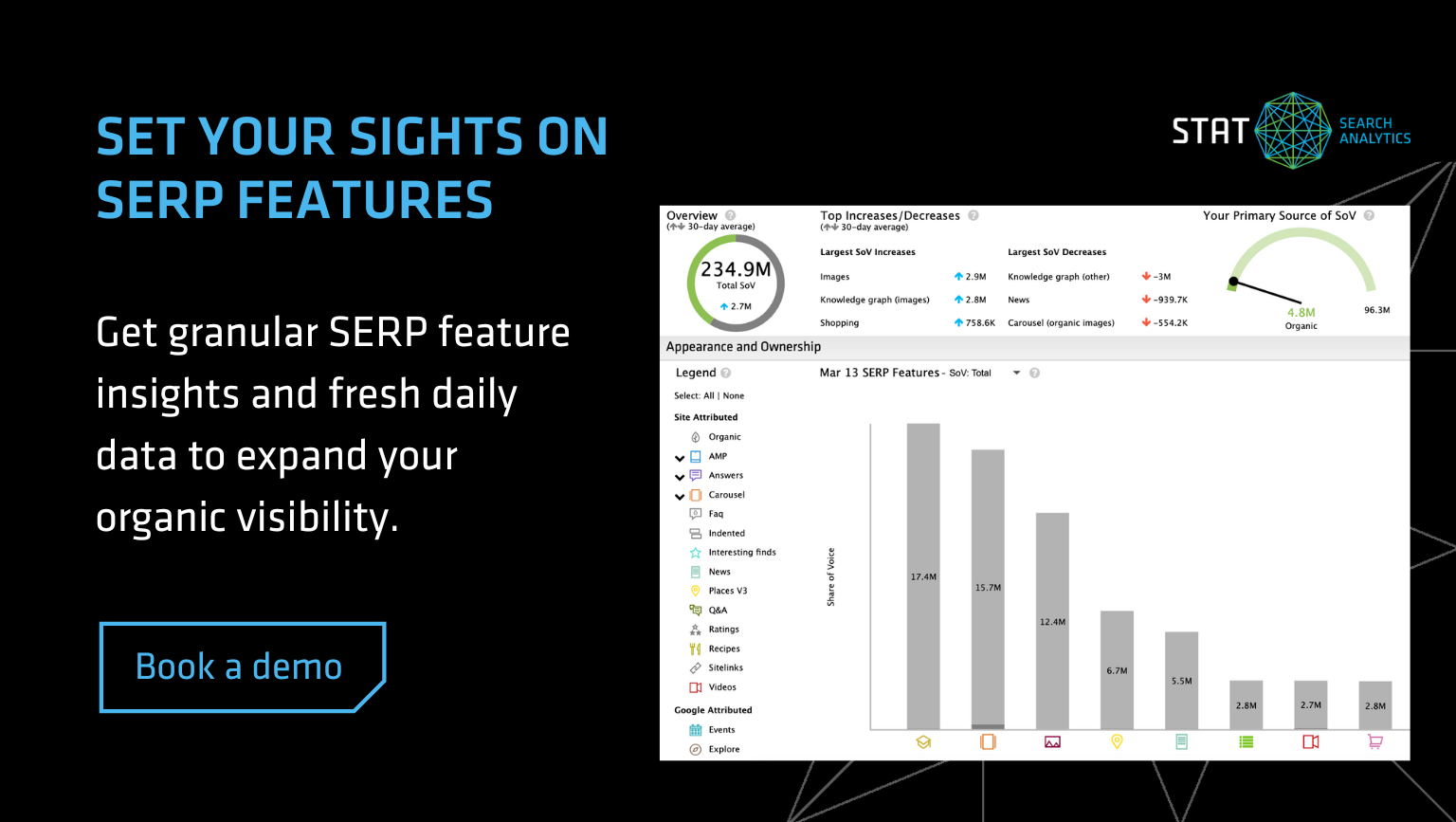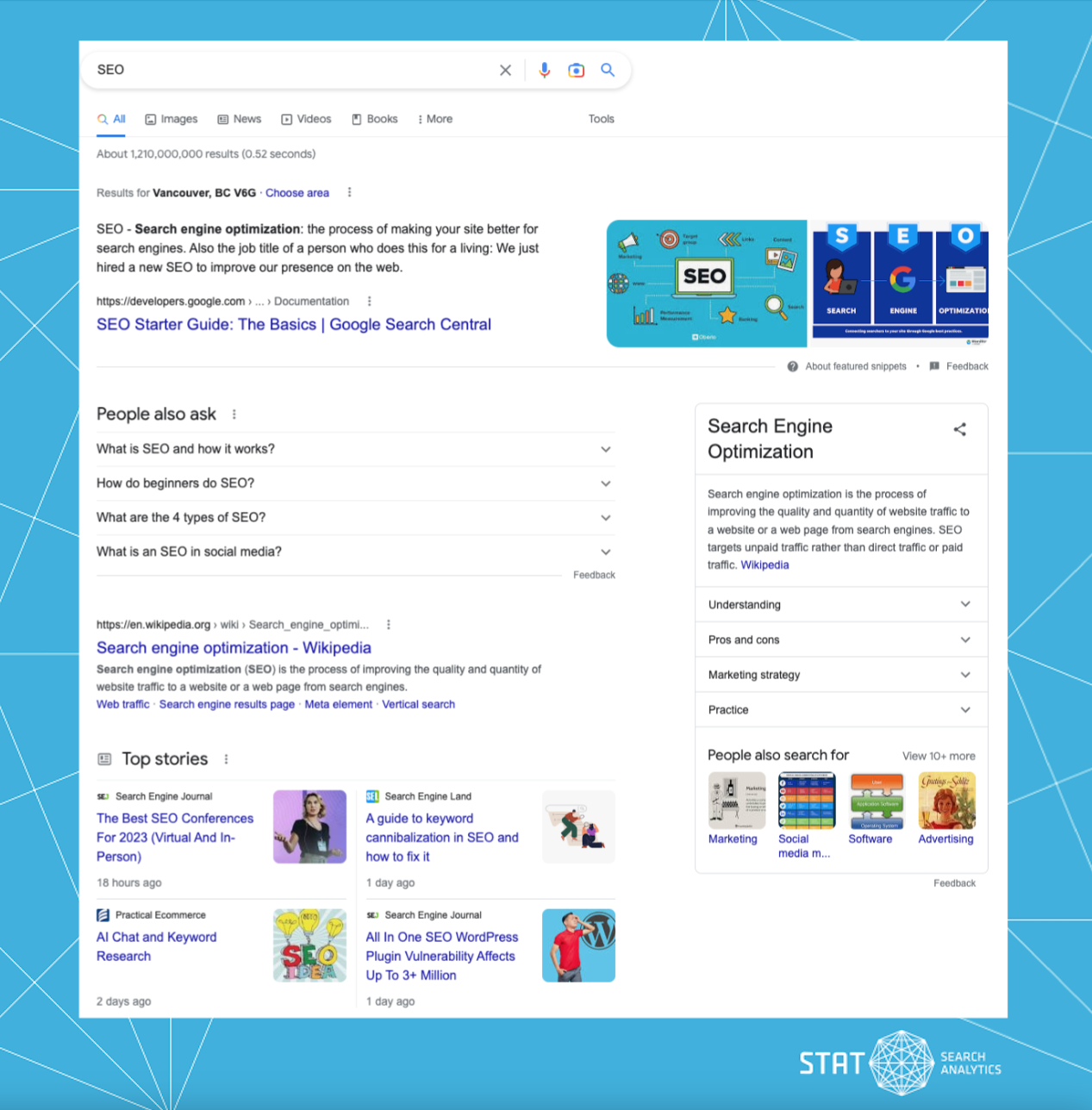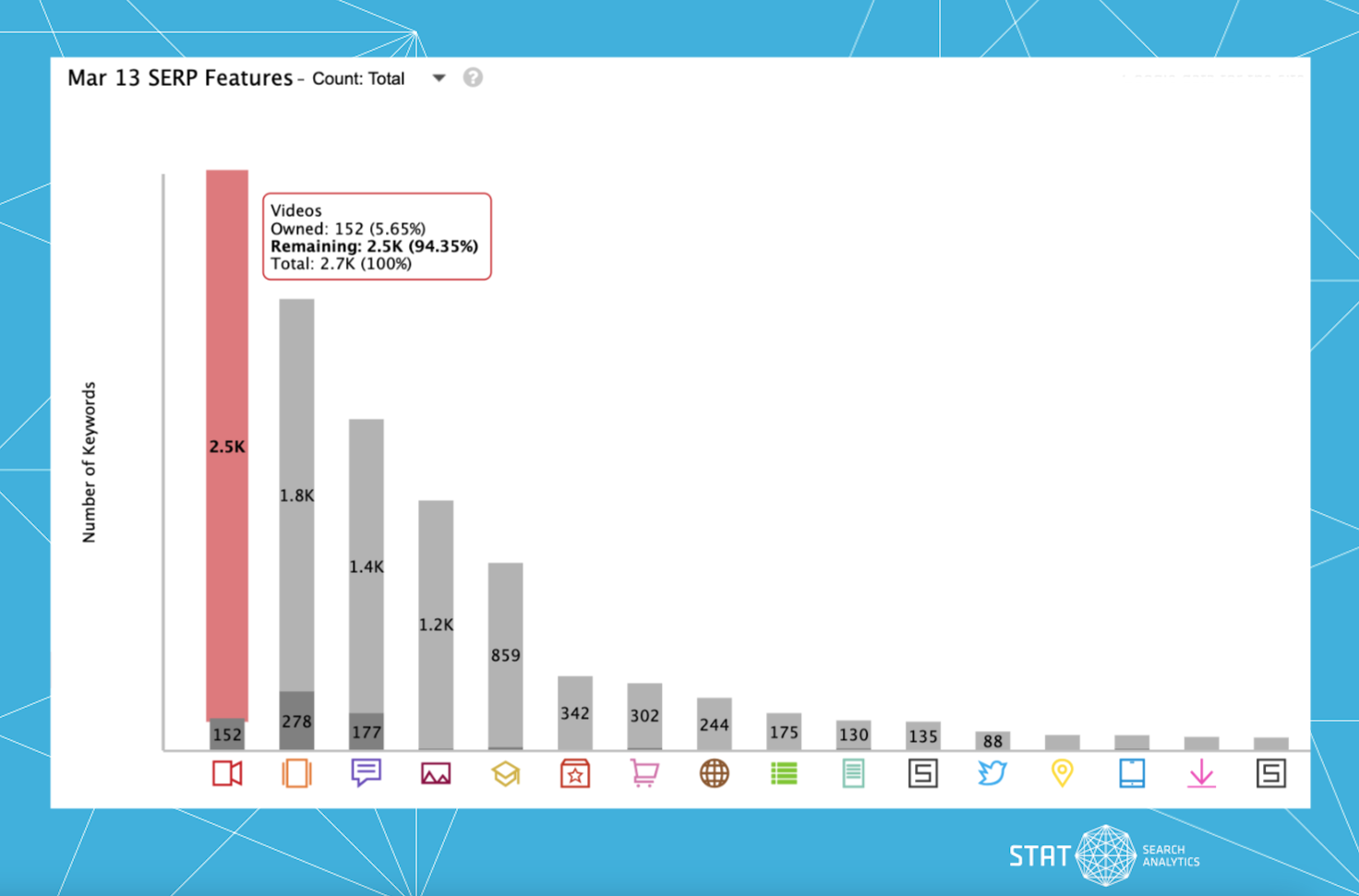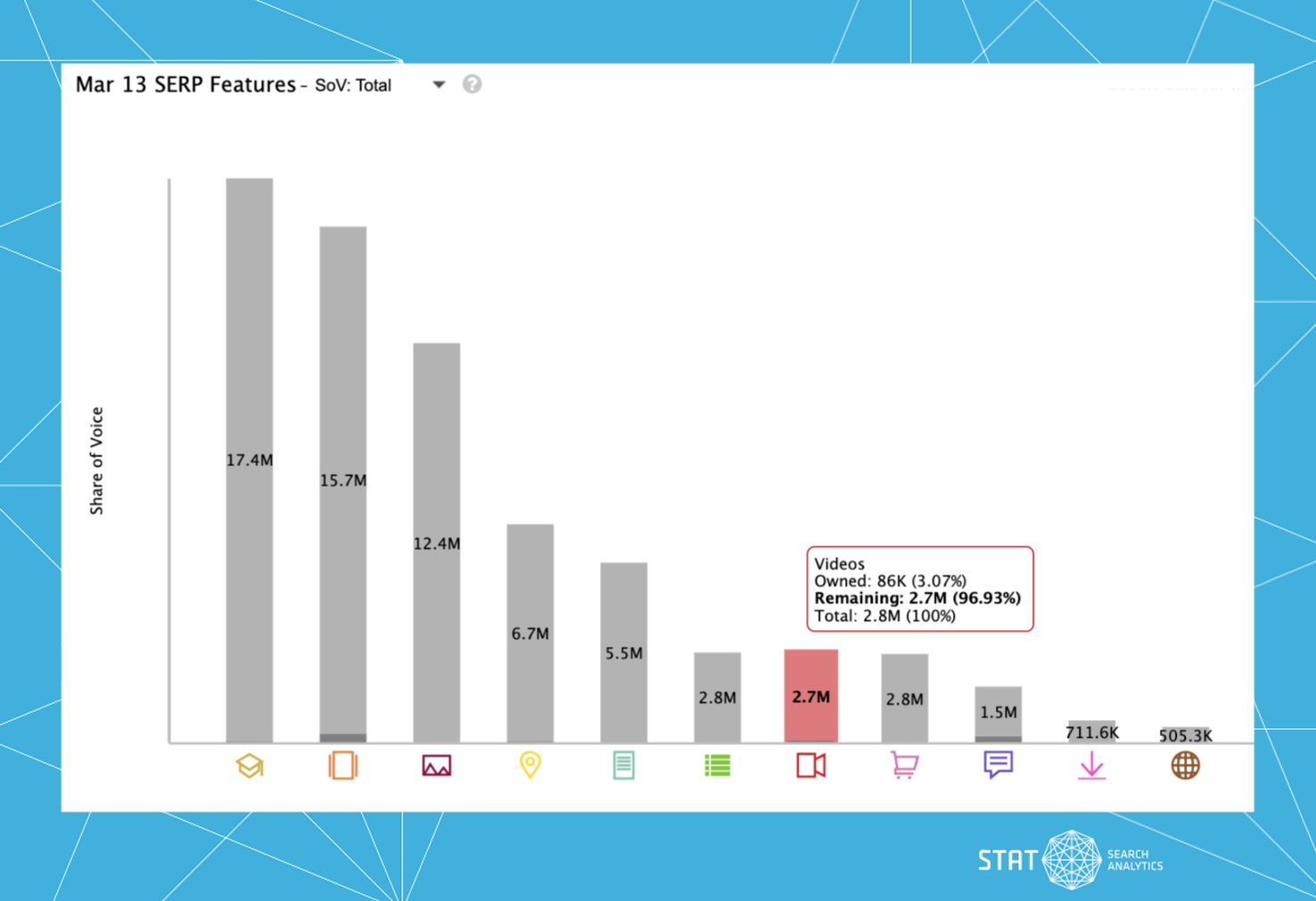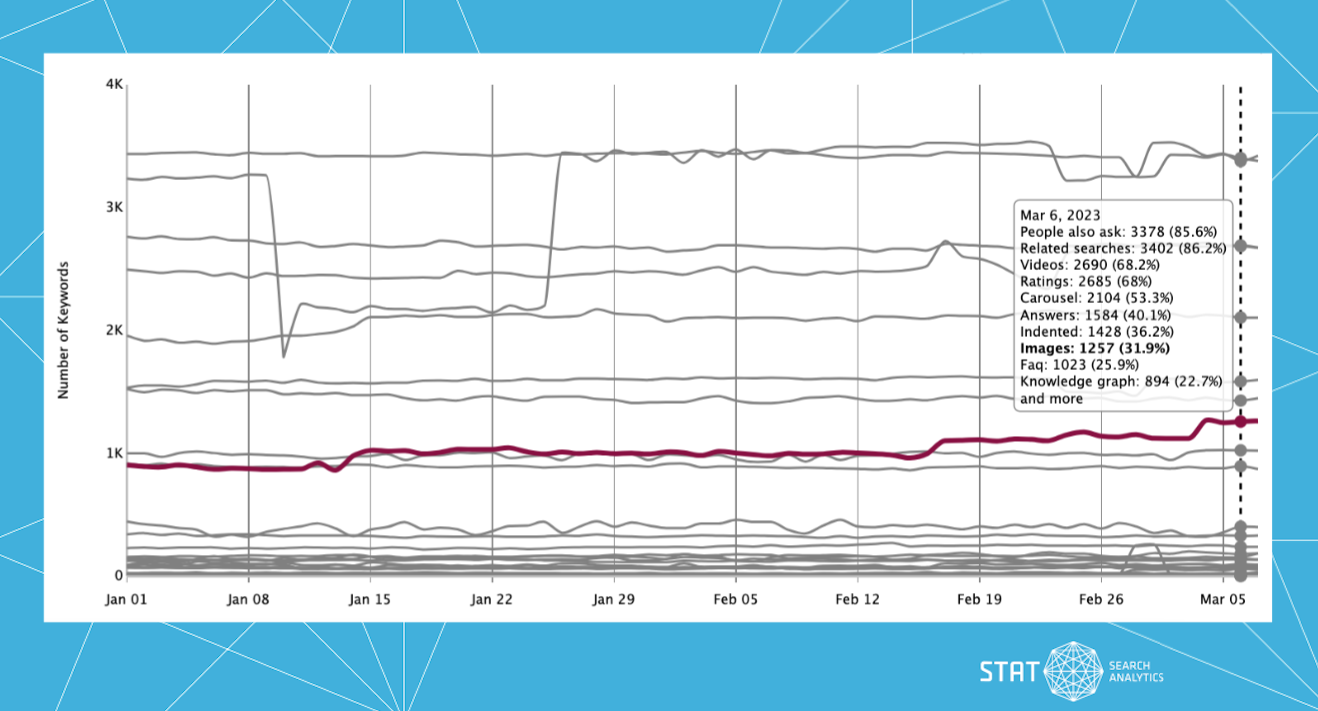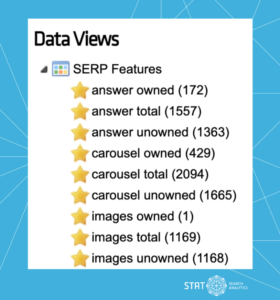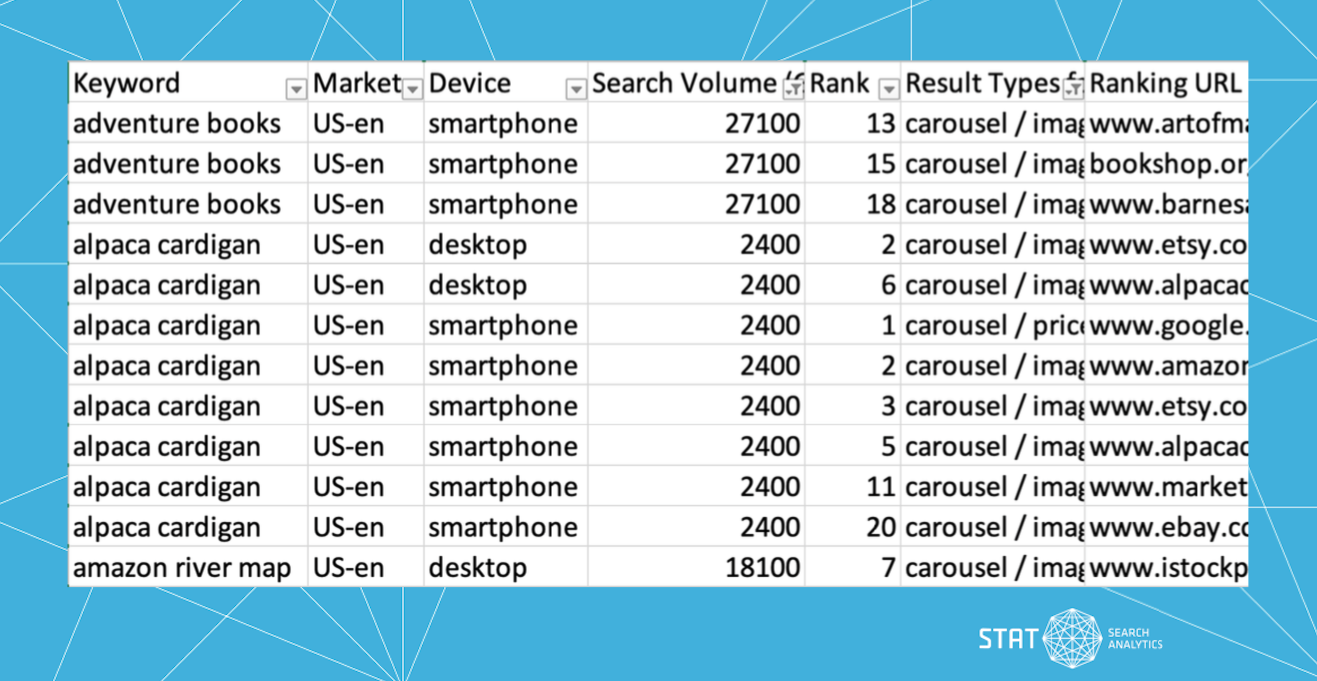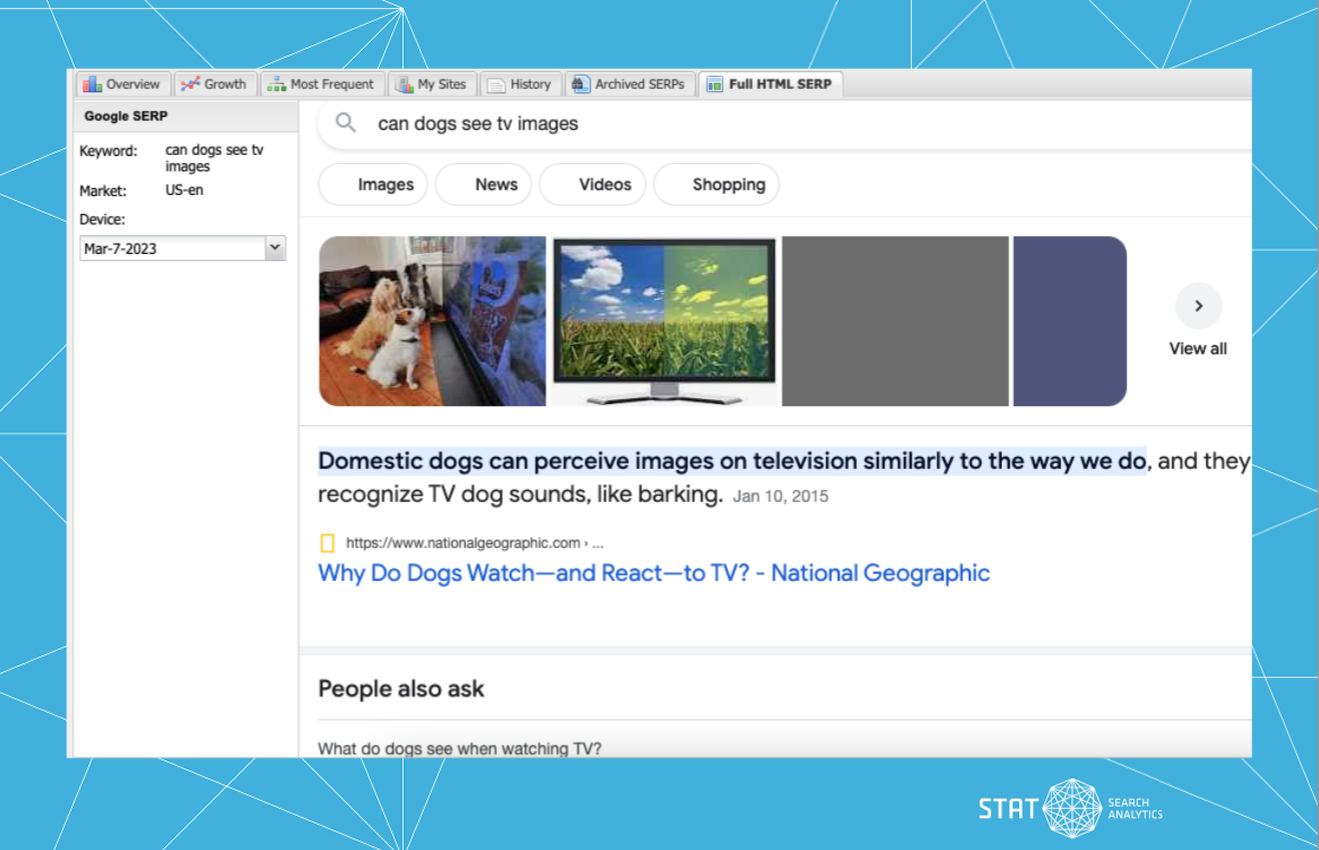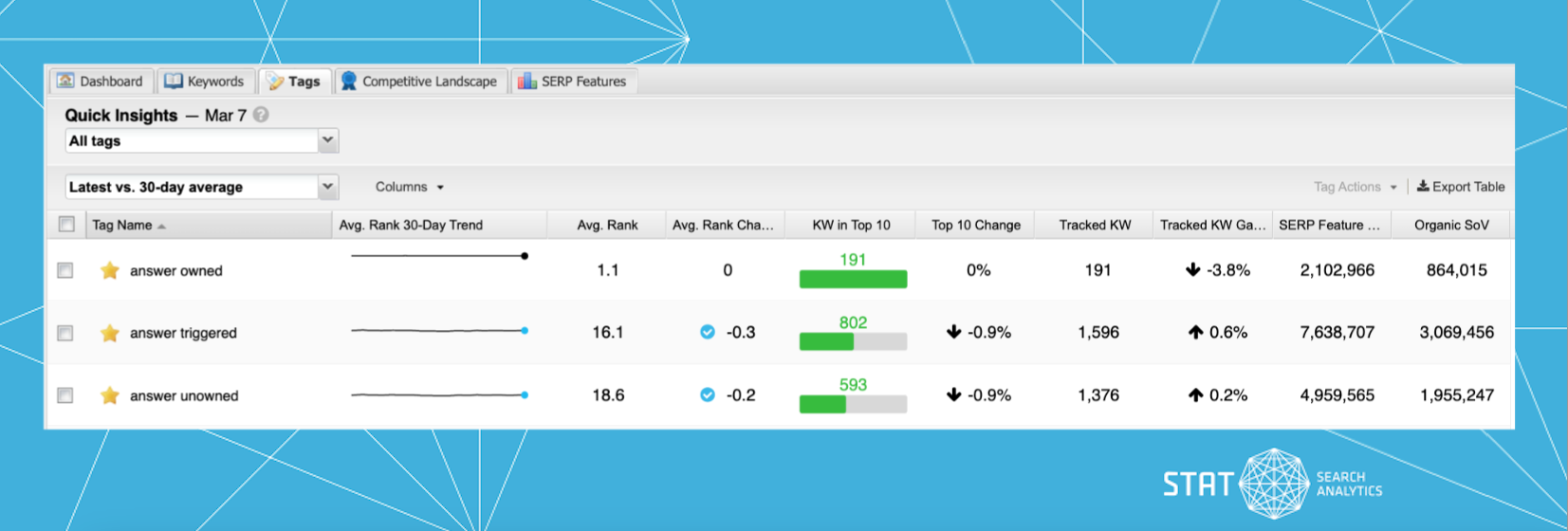We’ll show you how to navigate the treacherous tides of search and set sail for SERP feature glory.
In Google’s ongoing quest to keep searchers on the SERP and answer their queries ASAP, long gone are the days when the first page of results was a plain list of ten blue links.
And while the blue links remain, they’re now surrounded, and often outnumbered, by SERP features — flashy extras that add more information to the SERP itself (and look good doing it) — as Google experiments and search evolves.
If you have your sights set on SERP feature gold, we’ll walk you through how to stake your claim quicker than you can say “featured snippet.”
We’ll cover:
- What are SERP features & why should you care about them?
- How to tailor a SERP feature strategy to your site
- Step 1: Scope out your SERP feature landscapes
- Step 2: Identify your target SERP features
- Step 3: Set up your SERP feature tracking
- Step 4: Identify strategic optimizations & layer in competitive insights
- Step 5: Track your performance over time
What are SERP features & why should you care about them?
While SERP features are notoriously volatile and can be tricky to pin down, at their core they can most simply be defined as any enhanced search result that goes beyond the aforementioned plain ol’ blue link.
Today, there are a great deal of SERP features appearing in the wild and they come in all shapes and sizes — from featured snippets to carousels, videos to knowledge graphs — the vast (and growing) array can be staggering. And while we won’t discuss each exhaustively in this post, you can see the full list of SERP features that are parsed in STAT here.
The wide world of SERP features
Gone are the days of simple blue links on the SERP.
While not all SERP features are made equal — and the relative value of a certain feature will vary wildly depending on your industry, market, and competitive landscape — they present a golden opportunity for SEOs to expand their footprint and own more real estate on the SERPs.
The bottom line is: SERP features capture more eyes from searchers, and more eyes means more potential clicks, which ultimately means more traffic to your site.
How to tailor a SERP feature strategy to your site
With so many SERP feature fish in the sea, how do you know the right ones for your site?
Choosing the best SERP features to target comes down to understanding not only your industry and its competitive landscape, but your audience, what they are searching for, and the intent behind those keywords.
Let’s dive right into our sure-fire five-step process.
Step 1: Scope out your SERP feature landscapes
The first step to surfacing the golden needles in your SERP feature haystacks is getting the lay of the lands. By understanding just which SERP features are being triggered for your various keyword segments, you’ll know what opportunities are up for grabs.
If you’re working in STAT, an easy way to do this quickly and at scale is with the SERP Features tab. Simply select the site, data view, or tag-level segment you’re interested in diving into, and then head over to the current day’s SERP Features bar chart and toggle on Count: Total.
SERP Features (Count: Total)
This graph will show you the total number of keywords that produce a given SERP feature so you can see just how prevalent they are in your space.
This will show you the SERP features that appear most in your space. In our example above, that would be videos, carousels, featured snippets, images, knowledge graphs, and so on down the line.
Next you’ll want to switch the view to SoV: Total to see how much share of voice potential each SERP feature has — as you may find that even a few features can pack a big visibility punch.
SERP Features (SoV: Total)
When the SERP Features chart is toggled to SoV: Total it tells a different story.
When analyzed by share of voice, videos actually places behind several other features despite being triggered by the highest number of keywords for this segment.
(For a more in-depth look at everything this tab can do, check out this overview of the SERP Features tab.)
Step 2: Identify your target SERP features
Now that you know the SERP feature sandbox you’re playing in, it’s time to pinpoint the specific SERP features you want to build your strategy around. To set your sights on the most advantageous features, start by asking yourself these questions:
Which SERP features align with your business goals?
When assessing which SERP features make the most sense for your site, it’s important to hone in on those that map to your business goals.
Think about which ones: are most applicable to your business; would be most helpful to users; would help you take up more organic real estate; or would encourage desired user actions.
For example:
- For eCommerce businesses, shopping boxes and images would be top considerations as they encourage searchers to explore the product.
- For a cooking blog, recipes could be an obvious choice.
- For a local business, focussing on local packs would make the most sense.
On the flip side, you’ll want to ignore those that simply won’t be relevant to your site.
The Recipes SERP feature
When it makes sense for your site, this tasty SERP feature represents an opportunity to gain additional visibility for your business.
Which SERP features do you already own and can you own more of them?
A great place to start carving out conquesting goals is with the SERP features you already own, as you likely have an existing framework of success to build off of. So, if you own 12% of occurrences for a particular SERP feature, is there potential to edge into the remaining 88%?
This can also flag an opportunity to reevaluate your current approach. If you notice high ownership of SERP features that don’t align with your business goals or are more effort than they’re worth, you could decide to move away from them in the future.
Plus, understanding where you’re starting from is essential to a sound strategy. This will help you benchmark your current state so you can ensure that you’re defending your turf and tracking your progress over time.
SERP Features (Count: Total)
The SERP Features bar graph toggled to Count: Total will show the number of SERP features surfaced within your keyword set, split into those you appear in and those you don’t.
Which SERP features have the highest or increasing visibility in your space?
Expand your footprint on the SERP and get ahead of the game by targeting features that look to be on the rise.
You’ll also want to make sure you’re thinking about prioritizing SERP feature targets based on the most prominent ones in your keyword set (keeping in mind that they make sense for your business).
SERP Features Over Time
Upon closer inspection, we can see that images are creeping up in prevalence over time — a factor to consider when prioritizing targets.
Which SERP features are easier to influence?
It’s important to note that some SERP features are easier to win than others. For example:
- Some can be influenced by changes you make to your site — like adding schema markup to help attract a featured snippet, or by claiming your Google My Business profile to help land a local pack.
- Others are more at the whim of Google — like the images that end up housed in a carousel.
- And others still, like shopping boxes and Google Guaranteed, are pay-to-play. You may not consider these as being in your SEO wheelhouse, but you should know how much visibility they’re pulling away from your organic results — this information is vital to your strategy and also helpful for your advertising team.
You want to make sure that you’re spending your time (and money) productively.
Step 3: Set up your SERP feature tracking
Once you’ve narrowed down the types of SERP features you’d like to target, you’ll want to set yourself up for success by segmenting your keywords into meaningful SERP feature buckets. This will let you track you performance over time and pinpoint new opportunities along the way.
We recommend creating a core set of dynamic tags for the keywords that trigger the SERP features you care about.
Dynamic Tags in STAT
We’ve got a lovely bunch of dynamic tags — here they are, all standing in a row.
We suggest these three tags for each target SERP feature:
• Total — this will show the total number of keywords returning the SERP feature. Watch this tag to see whether Google is adding or removing features from your SERPs.
• Owned — this will show how many of that total you actually own. When you see this number go up, you’ll know you’re onto a winning strategy.
• Unowned — this will show how many you have yet to own. This is one of the few numbers you want to see go down as you see the gradual results of your optimizations.
Check out this quick video to see the SERP Features dashboard in action and learn how to quickly create dynamic tags.
Step 4: Identify strategic optimizations & layer in competitive insights
Once you have your SERP feature segments tagged out, you can dig into the data and begin crafting a plan around the technical and content optimizations needed to land said features.
Enter STAT’s Top 20 Comparison Report, a powerful little data export that allows you to get extra granular with your SERP feature research and glean powerful insights to inform your strategy. It will show you every SERP feature — along with its ranking position and URL — that appears in the top 20 Google search results for a given keyword set.
So, not only can you see which SERP features are owned by which competitors, but you can use those ranking URLs to analyze what your competitors have done to win them those features — and reverse-engineer their strategy against them.
With vast amounts of data at hand, filters are your friends. Put these handy little helpers to work zeroing-in on your top targets. Filter by:
- Rank (we recommend looking at keywords ranking on the first two pages: rank ≤ 20) to identify opportunities within striking distance.
- Search volume to identify targets with the highest potential in terms of driving traffic.
When you land at the sweet intersection of a high search volume keyword, where you have a high organic ranking, and do not own the SERP feature — ‘X’ marks the spot. These are the prime opportunities you’re searching for.
Filtered Top 20 Comparison Report
The power of the Top 20 Comparison Report is in filtering the cold hard data to surface insights.
For example, in the Top 20 Comparison Report above, we filtered for keywords that returned a carousel, ranked ≤ 20, and had a search volume > 1000, to hone in on attainable carousel keyword targets with high traffic potential.
As a bonus, you may find that a surprising competitor surfaces from the bunch and warrants further analysis. Often, your search competitors will not be limited to only direct competitors already on your radar.
And the fun doesn’t stop there. You can zoom in on specific competitors that you want to target directly. Simply filter by their URLs and you’ll see every SERP feature they’re winning and the content that’s being pulled in.
The Full HTML SERP tab
SERPs are complicated territory these days. Take guesswork out of the equation and get eyes on exactly how features are showing up on the SERP.
And, finally, as you’re diving into these reports, if you’re ever curious about how a particular feature appears on the SERP and need figurative eyes on the ground, the Full HTML SERP tab in STAT provides just that.
As you see what the expanded SERP footprint looks like and analyze the competitor pages that are winning each feature, you may start seeing patterns in the types of content or structured data that you can leverage for your own pages to provide similar (or better!) information.
Step 5: Track your performance over time
Once you’ve executed on all the opportunities you uncovered in the previous steps, it’s time to reap the fruits of your labour. As you make improvements to your target pages, you’ll need to track performance over time to see the impact of your work and prove your efforts.
And while these just scratch the surface of the possible reports you can pull — whether you’re spot-checking progress from a high level or communicating to stakeholders, here are some of our favorite dashboards and reports for SERP feature tracking in STAT:
See your tag performance at a glance
Use the Tags tab to spot-check all the SERP feature dynamic tags you set up earlier.
This bird’s-eye view provides an easy way to compare your tags side-by-side and identify which of your SERP features are seeing movement and require deeper investigation.
The Tags tab
See Quick Insights, rolling average 30-day trends, and % gained/lost for keywords in each of your dynamic tags.
Monitor SERP feature ownership and volatility over time
By monitoring Count: Owned performance in the SERP Features Over Time chart, you’ll get a quick snapshot of your optimization successes over time (ideally, you see this total go up).
Also helpful for measuring the appearance of SERP features in your space, this is your go-to graph to answer questions like: Are the SERP features you’re after relatively stable or extremely volatile? How are they fluctuating? Are they increasing or declining in prevalence over time?
SERP Features Over Time graph
While ridden with volatility, we can see here that ownership of carousel SERP features is largely on the up and up over time.
Track which keywords enter and exit your SERP feature tags
We also have the nifty Dynamic Tag In/Out report, which tells you exactly which keywords are moving in and out of your dynamic tags — you’ll know what’s shifting between your ‘Owned’ and ‘Unowned’ tags without missing a beat.
In the example below, we can see that the keyword [all about wolves] came to own a video SERP feature on January 10, until it fell out of that “owned videos” tag on February 28, before hopping back in the following day.
Dynamic Tag In/Out Report
This handy report will easily allow you to keep an eye on and analyze which keywords are moving in and out of your dynamic tags.
Share your progress with key stakeholders
And if you’re reporting to an external audience, or just really need to impress your boss, you can also report on specific tag performance using STAT’s Looker Studio Tag-Level Connectors, which are a great way to visualize data and distill it down for a broader, non-data-nerdy crowd.
An SEO’s work is never done. Use the findings from your ongoing monitoring and reporting to iterate on your approach — building on successes and learning from failures — to tweak your strategy as you go.
To SERP feature greatness… and beyond!
And there you have it!
Now that we’ve charted a course through the volatile SERP feature waters, you should be feeling more confident in your ability to: understand your SERP feature landscape; zero-in on the best features for your site; glean actionable content and competitor insights from your data; and report on your progress as you go.
If you’re not already using STAT and this sounds like an adventure you’re up for, say hi — we’d be happy to take you on a guided tour of the tool.
Best of luck out there and may the SERP features be ever in your favour!
